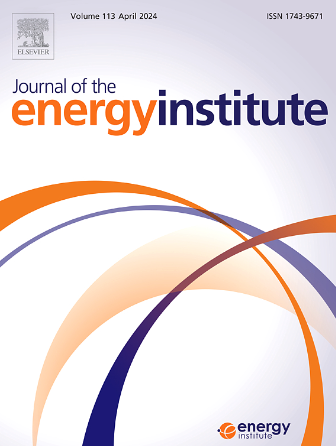Research progress of the synergistic removal of nitrogen oxides(NOx)and chlorinated volatile organic compounds(CVOCs)in industrial flue gas
IF 5.6
2区 工程技术
Q2 ENERGY & FUELS
引用次数: 0
Abstract
The escalating proportions of nitrogen oxides (NOx) and chlorinated volatile organic compounds (CVOCs) emissions from industrial flue gas have caused widespread concern. Presently, NH3-SCR technology has attained widespread industrial application. The synergistic removal of NOx and CVOCs within denitrification equipment is a promising and practical technology. However, in practical industrial emissions, complex components in flue gas will negatively affect the synergistic removal of NOx and CVOCs. In this paper, the characteristics of NH3-SCR and CVOCs catalytic oxidation reaction systems were systematically summarized separately, and the reciprocal interaction mechanism of the two reaction systems in the synergistic collaborative removal of NOx/CVOCs was discussed in detail. In addition, it conducts a multifaceted analysis to outline the impacts of additional gas constituents (SO2, heavy metals, HCl) in complex environmental settings on the NOx/CVOCs co-abatement process. Furthermore, the method of designing the catalyst to obtain the appropriate surface properties by adjusting the electron structure and electron conductivity is introduced. In conclusion, the study delineates its limitations and proposes avenues for future research development. It is envisaged that this review can bridge the gap between the development of catalysts for the synergistic removal of NOx/CVOCs and the practical imperatives, thus furnishing invaluable insights for industrial implementation.

求助全文
约1分钟内获得全文
求助全文
来源期刊

Journal of The Energy Institute
工程技术-能源与燃料
CiteScore
10.60
自引率
5.30%
发文量
166
审稿时长
16 days
期刊介绍:
The Journal of the Energy Institute provides peer reviewed coverage of original high quality research on energy, engineering and technology.The coverage is broad and the main areas of interest include:
Combustion engineering and associated technologies; process heating; power generation; engines and propulsion; emissions and environmental pollution control; clean coal technologies; carbon abatement technologies
Emissions and environmental pollution control; safety and hazards;
Clean coal technologies; carbon abatement technologies, including carbon capture and storage, CCS;
Petroleum engineering and fuel quality, including storage and transport
Alternative energy sources; biomass utilisation and biomass conversion technologies; energy from waste, incineration and recycling
Energy conversion, energy recovery and energy efficiency; space heating, fuel cells, heat pumps and cooling systems
Energy storage
The journal''s coverage reflects changes in energy technology that result from the transition to more efficient energy production and end use together with reduced carbon emission.
 求助内容:
求助内容: 应助结果提醒方式:
应助结果提醒方式:


